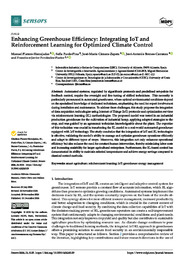Please use this identifier to cite or link to this item:
https://hdl.handle.net/11000/35269Full metadata record
| DC Field | Value | Language |
|---|---|---|
| dc.contributor.author | Platero Horcajadas, Manuel | - |
| dc.contributor.author | Pardo Pina, Sofía | - |
| dc.contributor.author | Cámara-Zapata, José-María | - |
| dc.contributor.author | Brenes Carranza, José Antonio | - |
| dc.contributor.author | ferrández-pastor, francisco-javier | - |
| dc.contributor.other | Departamentos de la UMH::Física Aplicada | es_ES |
| dc.date.accessioned | 2025-01-24T13:52:53Z | - |
| dc.date.available | 2025-01-24T13:52:53Z | - |
| dc.date.created | 2024-12-19 | - |
| dc.identifier.citation | Sensors 2024, 24(24), 8109 | es_ES |
| dc.identifier.issn | 1424-8220 | - |
| dc.identifier.uri | https://hdl.handle.net/11000/35269 | - |
| dc.description.abstract | Automated systems, regulated by algorithmic protocols and predefined set-points for feedback control, require the oversight and fine tuning of skilled technicians. This necessity is particularly pronounced in automated greenhouses, where optimal environmental conditions depend on the specialized knowledge of dedicated technicians, emphasizing the need for expert involvement during installation and maintenance. To address these challenges, this study proposes the integration of data acquisition technologies using Internet of Things (IoT) protocols and optimization services via reinforcement learning (RL) methodologies. The proposed model was tested in an industrial production greenhouse for the cultivation of industrial hemp, applying adapted strategies to the crop, and was guided by an agronomic technician knowledgeable about the plant. The expertise of this technician was crucial in transferring the RL model to a real-world automated greenhouse equipped with IoT technology. The study concludes that the integration of IoT and RL technologies is effective, validating the model’s ability to manage and optimize greenhouse operations efficiently and adapt to different types of crops. Moreover, this integration not only enhances operational efficiency but also reduces the need for constant human intervention, thereby minimizing labor costs and increasing scalability for larger agricultural enterprises. Furthermore, the RL-based control has demonstrated its ability to maintain selected temperatures and achieve energy savings compared to classical control methods | es_ES |
| dc.format | application/pdf | es_ES |
| dc.format.extent | 24 | es_ES |
| dc.language.iso | eng | es_ES |
| dc.publisher | MDPI | es_ES |
| dc.rights | info:eu-repo/semantics/openAccess | es_ES |
| dc.rights | Attribution-NonCommercial-NoDerivatives 4.0 Internacional | * |
| dc.rights.uri | http://creativecommons.org/licenses/by-nc-nd/4.0/ | * |
| dc.subject | Smart agriculture | es_ES |
| dc.subject | Reinforcement learning | es_ES |
| dc.subject | IoT | es_ES |
| dc.subject | Greenhouse energy management | es_ES |
| dc.title | Enhancing Greenhouse Efficiency: Integrating IoT and Reinforcement Learning for Optimized Climate Control | es_ES |
| dc.type | info:eu-repo/semantics/article | es_ES |
| dc.relation.publisherversion | https://doi.org/10.3390/s24248109 | es_ES |

View/Open:
Enhancing Greenhouse Efficiency_ Integrating IoT. and Reinforcement.pdf
3,43 MB
Adobe PDF
Share:
.png)
